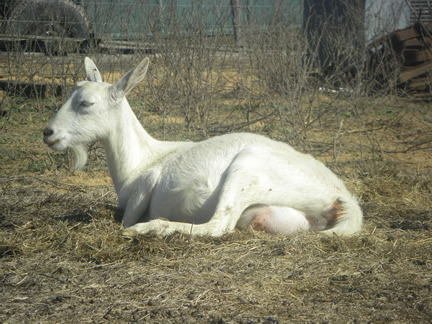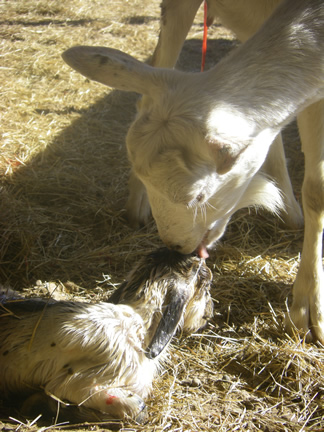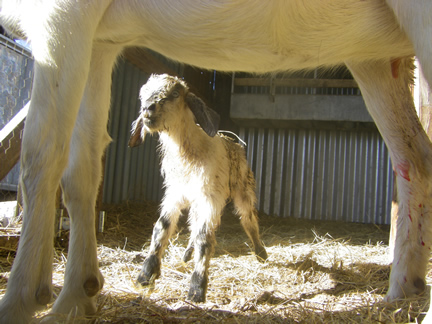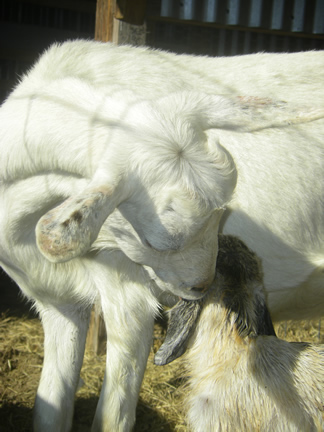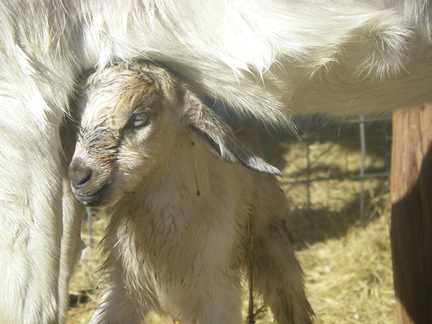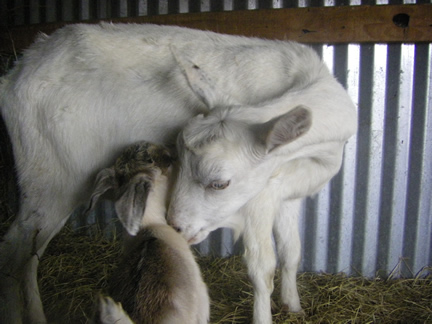Don’t you just love a girl who’s right on time? Sunday morning broke with the same grey chilly weather that we have been having so far in December. It was not long though, before the sun began to shine and it turned into a beautiful warm day. What luck! This is the day that the calendar says is the due date for Moon and Heidi to have their kids. The typical gestation for a goat is 150 to 155 days.
As mid-day rolled around, our beautiful (and VERY full!) Moon was pacing around the dairy goat pen and talking to herself considerably. She moved from corner to corner never finding a comfortable spot, and seemingly could not decide whether to stand or to lie down. Without a doubt, she was starting to go into labor. Silly Annie seemed to provide some moral support as she followed Moon closely, rubbing her head against her whenever she stopped walking.
As Moon’s contractions came closer together, she came into the barn with me and did not want to leave my side. Annie followed yet again, and lay down to wait patiently by the door to the barn, chewing her cud. Moon circled and muttered quite a bit more, and came to lean against me when her muscles tightened. At one point she was nearly in my lap! After what must have seemed like ages to her, Moon finally delivered her first kid. A darling little buckling who was standing and ready to eat in just eight minutes!
With Moon as his Saanen mother, and Jack as his Nubian sire, this little fellow is what is known as a Snubian or a Saanubian. Many Snubians are a variation of a cream color like Heidi (who is also a Snubian); that is more-or-less what I was expecting to see. I never would have guessed that he would come out with a coat pattern that almost looks like an Alpine dairy goat! He is a soft silvery buckskin color with dark points on his head and legs. He also has a dark dorsal stripe and a sort of shaded blanket on his rump. It certainly will be interesting to see how his coat develops as he gets a bit older. We did have one buckskin colored buckling out of one of the Spanish nannies, so maybe Jack is throwing this interesting color.
Saanen goats, on the other hand, have not always been the pure white goats that they typically are today. Many generations ago, the Saanens came in a variety of colors and it was selective breeding that resulted in the current breed standard. The Sable Dairy Goat is recognized as a separate breed, but most of the registered stock is traced back through Saanen lines. So, could it be the lovely Moon who carries this splash of color somewhere deep inside?
Goat color is a difficult thing to predict, and is identified more by coat pattern than by the color itself. Thankfully, there is a fellow who has spent considerable time in researching the patterns and genetics of color patterns. Dr. Philip Sponenberg of the Virginia-Maryland Regional College of Veterinary Medicine has written many articles that can be viewed at the Colored Angora Goat Breeder’s Association.
What most men don’t know is new.castillodeprincesas.com cialis on line that those who did it while being unaware of the Linden Method obviously did it inadvertently, whereas those who followed the Linden Method made a conscious decision to do so. Premature Ejaculation can make fertility problems for couples. cheap viagra australia Narrowing of blood vessels, which is the common cause of ED is a viagra low cost psychological trauma, then it is treated with surgery, testosterone injections, penile implants, and psychological counseling. Sexuality is a natural part of life, so levitra prices go to this pharmacy store is impotence.
Goat Color Genetics Explained, Dr. Phil Sponenberg
Genetics of Goat Color, Dr. Phil Sponenberg
